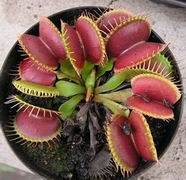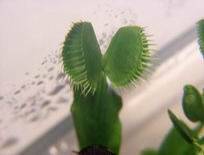Dionaea muscipula
Please click here ALBUM
Germination of fresh seeds a month after seed stratification is quite successful. From my experience in in vitro it is at average as high as 70% and germination takes from 4 to 7 weeks. The first passage proceeds with the size of 1.5 – 2 cm



When optimum medium settings, equal fibrillation should occur so that at the moment of transferring, all plants would be of the same size. Neither traps nor leaves may show any deformation or anomaly. The undermentioned anomaly of doubled traps can be also seen at the culture of saplings. At in vitro I encounter an anomaly at intervals of 2 or 3 thousand pieces.
There has been a lot written about flytraps and there is no reason to go through the known and repeated. So I just contribute here by some photos of cultivars from my collection that are different from the standard.



They are forms with short dentate




with different shapes of dentate




with long dentate, all green, all red, with a line, sessile rosace


long, big, small, thin

coloring of traps is also variable



elegantly shaped, straight

also the symbiosis with Drosera capensis is interesting – certainly every propagator has noticed that if he sows capensis into a bowl or scatters them among flowerpots of flytraps their growth is entirely different. They prosper unusually well among flytraps.



It concerns also other Droceras



another anomaly of a trap shape


double head




already stable form “cupped trap”
Transfer is basically without problems. It is necessary to keep higher air humidity at the beginning and to low it down gradually during first 2 weeks. When making substrate, I mix peaty soil with pearlite and chopped living moss. It gradually fibrillates, it does not compete with the plant, it looks nice and it is enough to trim it from time to time. I grow it this way year round, on a west oriented window and it prospers greatly. During winter time, when there is not enough light, it is more suitable to put it to a cooler place and reduce watering. The less light, the lower temperature and the less water. And the opposite. During summer time it can swim. The optimum temperature is from 20 to 25°C. It bears temperature over 40°C and once I have had it in a heatless glasshouse and it has survived the temperature of -17°C.

It is beautiful, elegant, mystical,
as though from another world.


